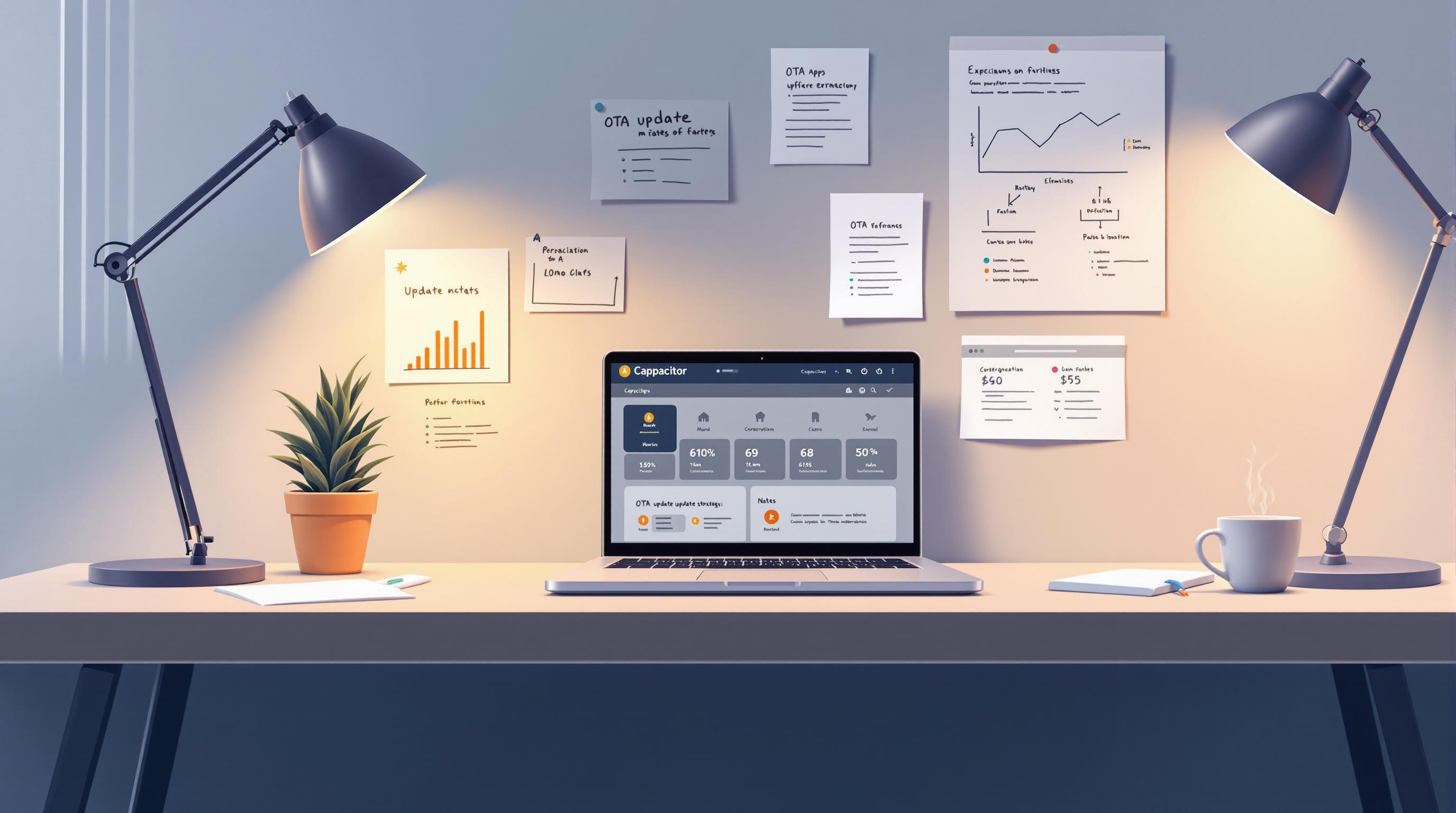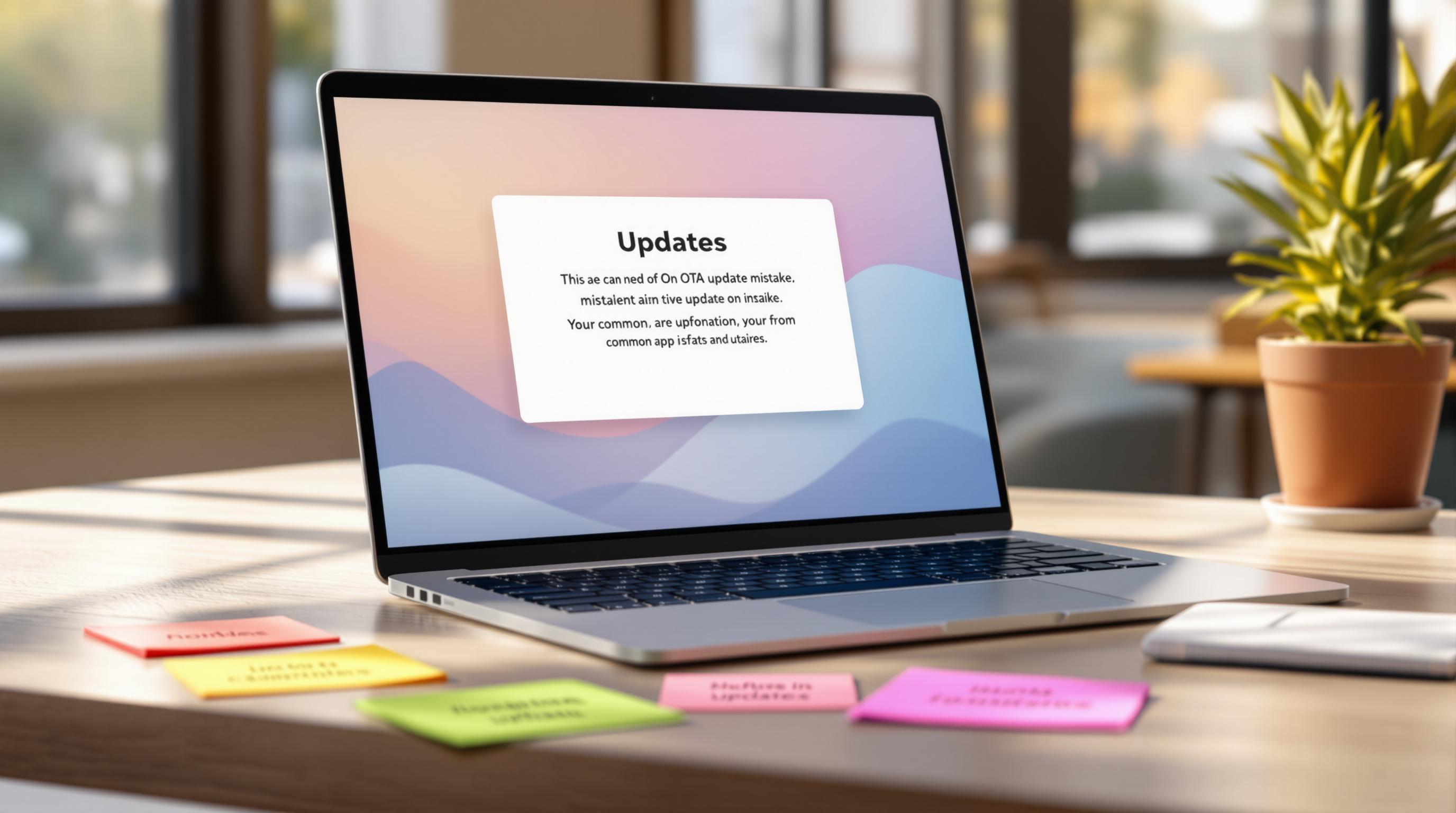OTA (Over-the-Air) updates allow Capacitor apps to update content like JavaScript, CSS, and HTML without requiring app store submissions. While convenient, these updates can impact app startup performance. Here’s a quick guide to optimize OTA updates for better performance and user experience:
-
Minimize Update File Size: Use techniques like differential updates, compression (e.g., ZSTD), and eliminating unnecessary file changes.
-
Efficient Code Loading: Prioritize loading core features first, delay non-critical components, and use lazy loading for heavy modules.
-
Incremental Updates: Break updates into smaller steps, schedule them during idle times, and use A/B systems for seamless rollbacks.
-
Secure Updates: Protect files with encryption, checksums, and code signing to ensure integrity.
-
Testing & Compliance: Test updates thoroughly and follow app store guidelines to avoid approval issues.
Quick Comparison of OTA Tools:
| Feature | capacitor-app-updater | capacitor-app-update | Capgo |
|---|---|---|---|
| Update Method | Checksum comparison | In-app updates | JS bundle updates |
| Performance Impact | Minimal | Medium | Low |
| Background Updates | No | Yes (Android) | Yes |
| Rollback Support | Limited | Platform-dependent | Built-in |
| CI/CD Integration | Manual | Manual | Automated |
Capgo stands out with features like background updates, end-to-end encryption, and performance tracking, making it a strong choice for managing OTA updates in Capacitor apps.
Ship real-time updates to your Ionic app users
Performance Tips for OTA Updates
These strategies tackle startup delays and ensure smoother OTA update processes by focusing on file size reduction and efficient code loading.
Reducing Update File Size
Keeping update file sizes small is essential for quicker downloads and faster startups. The idea is to transfer less data without sacrificing functionality. Here’s how you can achieve this:
-
Create a
live-update-manifest.jsonto enable differential updates. -
Use ZSTD compression for non-A/B devices to shrink full image updates.
-
Eliminate build timestamps and standardize build tools to avoid unnecessary file changes.
-
For A/B OTA updates, apply Puffin recompression to generate patches more efficiently.
Managing Code Loading
Startup speed isn’t just about file size - when code loads also matters. Here’s a smart approach to manage code loading:
-
Core Features First: Load essential functions like authentication and main navigation immediately.
-
Secondary Features Later: Delay loading for non-critical components like advanced settings, analytics, and animations.
-
Efficient Resource Use: Apply progressive or lazy loading for heavy modules and media after the app has launched.
Step-by-Step Updates
Breaking updates into smaller steps reduces disruptions during startup. Incremental updates are a practical way to ensure a seamless experience. For example, Android 8.0 uses streaming updates that require only about 100 KiB of metadata storage instead of downloading the entire package [3].
-
Schedule updates during idle times, such as overnight, and prioritize Wi-Fi connections.
-
Protect update files with encryption and checksum verification [1][2].
-
Use A/B partition systems to allow updates without interrupting app functionality [3].
Capgo provides built-in tools for secure, incremental updates, featuring end-to-end encryption and flexible deployment options.
sbb-itb-f9944d2
Setting Up OTA Updates in Capacitor

Setting up Over-the-Air (OTA) updates in Capacitor requires careful testing and adherence to strict guidelines.
Pre-Release Testing
Before rolling out updates, thorough testing is essential:
-
Use testing environments that closely replicate production settings.
-
Record baseline metrics like startup time, memory usage, bandwidth, and battery consumption.
-
Verify fallback mechanisms to ensure the server path resets if an update fails [4].
Once performance is stable, check that the updates meet app store regulations.
App Store Rules
To avoid issues with app store approvals, follow these platform-specific rules:
Apple App Store Requirements:
“Interpreted code may be downloaded to an Application but only so long as such code: (a) does not change the primary purpose of the Application by providing features or functionality that are inconsistent with the intended and advertised purpose of the Application as submitted to the App Store, (b) does not create a store or storefront for other code or applications, and (c) does not bypass signing, sandbox, or other security features of the OS.” [4]
Google Play Store Guidelines:
“This restriction does not apply to code that runs in a virtual machine or an interpreter where either provides indirect access to Android APIs (such as JavaScript in a webview or browser).” [4]
Using Capgo for Updates

After testing and ensuring compliance, deploying updates efficiently becomes the next step. Capgo is a tool that simplifies this process.
In February 2025, Capgo managed 449 million updates across 1.8K production apps [5]. Key features include:
-
End-to-end encryption to secure update delivery.
-
Caching of the latest bundle for faster load times [6].
-
Code signing to verify update authenticity.
-
CI/CD integration for smooth deployment.
-
Controlled rollouts through user assignment.
-
Version control with instant rollback capabilities.
-
Performance tracking with analytics.
-
Tools to monitor compliance.
By uploading only compiled code meant for app store distribution, Capgo minimizes overhead and boosts efficiency. This approach has reportedly led to an 81% improvement in release efficiency for users [5].
“We practice agile development and @Capgo is mission-critical in delivering continuously to our users!” - Rodrigo Mantica, @manticarodrigo [5]
Capgo also uses a custom Dart interpreter for iOS updates. This ensures updates remain within app store guidelines while still allowing for quick deployment [6].
OTA Update Tools Analysis
OTA tools for Capacitor differ in functionality and performance. Here’s a breakdown of how they stack up and what to keep in mind when choosing one.
OTA Platform Comparison
Here’s a quick comparison of key features across popular OTA tools:
| Feature | capacitor-app-updater | capacitor-app-update | Capgo |
|---|---|---|---|
| Update Method | Checksum comparison | In-app updates (Android) | JS bundle updates |
| Performance Impact | Minimal (selective downloads) | Medium (full app updates) | Low (background checks) |
| Update Scope | Web content only | Full app updates | JS code and dependencies |
| Platform Support | iOS & Android | Android-focused | iOS & Android |
| Background Updates | No | Yes (Android) | Yes |
| Rollback Support | Limited | Platform-dependent | Built-in |
| CI/CD Integration | Manual | Manual | Automated |
For instance, while capacitor-app-updater uses selective downloads to minimize performance impact, Capgo employs a background update mechanism that keeps the app responsive during updates [6]. These distinctions are crucial when selecting the right tool.
Selection Criteria
Based on the comparison, here are some important factors to consider when picking an OTA tool:
-
Update Efficiency
Capgo’s background update system has handled 449 million updates across 1.8K production apps without affecting performance [5]. -
Bundle Size Management
Look for tools that reduce update times by optimizing package sizes with differential downloads [7]. -
Native Code Handling
Ensure the tool excludes native code changes from updates. Capgo, for example, alerts developers if native code changes are detected [6]. -
Startup Impact
Choose tools that allow configurable delays for update checks to maintain smooth startup performance. This feature is available in capacitor-app-updater [7]. -
Update Verification
Reliable verification methods, like checksum systems, are essential to ensure update integrity. Both capacitor-app-updater and Capgo offer this, with Capgo adding end-to-end encryption for extra security [6].
Conclusion
Key Performance Tips
When adding OTA updates to Capacitor apps, focusing on both security and performance is essential. Below are some strategies to keep in mind:
| Strategy | How to Implement | Why It Matters |
|---|---|---|
| Security First | Build on existing security protocols | Protects update integrity |
| Size Optimization | Use compression techniques discussed earlier | Cuts down user wait times |
| Update Scheduling | Process updates in the background, Wi-Fi only | Reduces user disruption |
| Version Control | Separate updates for web and native layers | Ensures smooth compliance |
“OTA updates are a critical infrastructure component to nearly every embedded IoT device” [8]
This highlights the importance of creating a reliable update system that balances performance and security. Use these strategies to strengthen your OTA update process.
Next Steps
To maximize the efficiency of OTA updates in your Capacitor app, make sure to:




